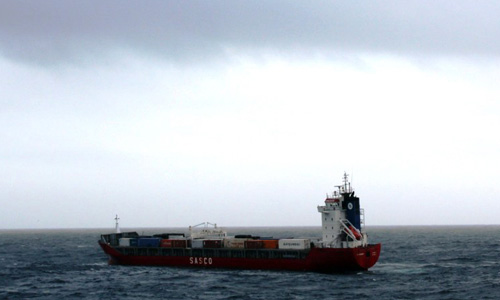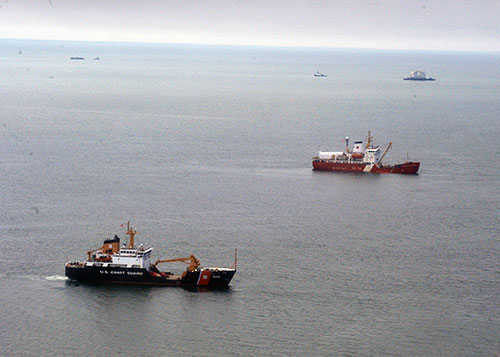
Adrift in Canadian watersBy KELLY PARKER
November 03, 2014
For Canada and the United States, the recent events of Oct. 17 provided that very opportunity. With 11 personnel aboard and an estimated 168,000 gallons of fuel, the 441-foot Russian freight vessel Simushir lost propulsion and drifted dangerously close to the coastline of the Queen Charlotte Islands, British Columbia.
The 441-foot Russian freight vessel Simushir adrift after losing propulsion along the coastline of the Queen Charlotte Islands, British Columbia, with 11 personnel aboard and an estimated 168,000 gallons of fuel.
With a storm forecasted to soon roll into the area, it became even more imperative to rescue the crew of the Simushir. The crews of Canadian coast guard vessels Sir Wilfrid Laurier and Gordon Reid arrived on scene and urgently tried to maneuver the freight vessel further out to sea and away from land. The crew of the Coast Guard Cutter SPAR, a 225-foot seagoing buoy tender homeported in Kodiak, quickly made way to the Simushir’s location with a State of Alaska Emergency Towing System onboard. The ETS was developed as a tool to assist disabled vessels and could be deployed either by helicopter or from a tug or other vessel of opportunity. The system was developed following the grounding of the 738-foot cargo vessel Selendang Ayu in December 2004 near Unalaska. In fact both the SPAR and the Sir Wilfrid Laurier had trained for a similar exercise during Arctic Shield 2013 near Teller, Alaska.
The crew aboard Coast Guard Cutter SPAR transfers a State of Alaska Emergency Towing System to the pier in Ketchikan, Alaska, during their response to the disabled vessel Simushir.
The 17th District also stood up their incident management team to direct Coast Guard assets and personnel support. Coast Guard Sector Juneau deployed six members, including the sector’s commander, to Ketchikan to establish the foundation for a unified command and to exercise their sub-area contingency plan with state and local partners.
The Coast Guard Cutter SPAR and Canadian Coast Guard ship Sir Wilfrid Laurier sail side-by-side during a VOSS equipment test near Teller, Alaska, July 18, 2013. The VOSS system uses a remote controlled skimmer, submersible pump, and inflatable barge to collect oil and small debris from the surface of the water.
“The trusted partnership we have with our Canadian counterparts continues to be a vital component to protecting lives at sea and mitigating potential maritime emergencies,” said Rear Adm. Dan Abel, commander, Coast Guard 17th District. “We are pleased this case ended with a positive outcome; preparing for the worst case scenario is the first step in an effective prevention and response plan.” This response showcased the continued support and unity between the two coast guards and highlighted our readiness to respond at a moment’s notice to those in need; a partnership that will continue to prove vital in the future between our common waters. “Assistance provided by the U.S. Coast Guard in the form of the USCGC SPAR and a U.S. Coast Guard helicopter at the ready in Sandspit, B.C. highlights the ongoing support that the U.S. and Canada provide to each other,” said The Honourable Gail Shea, Minister of Fisheries and Oceans Canada. “And for that I would like to extend my appreciation.”
|
||


